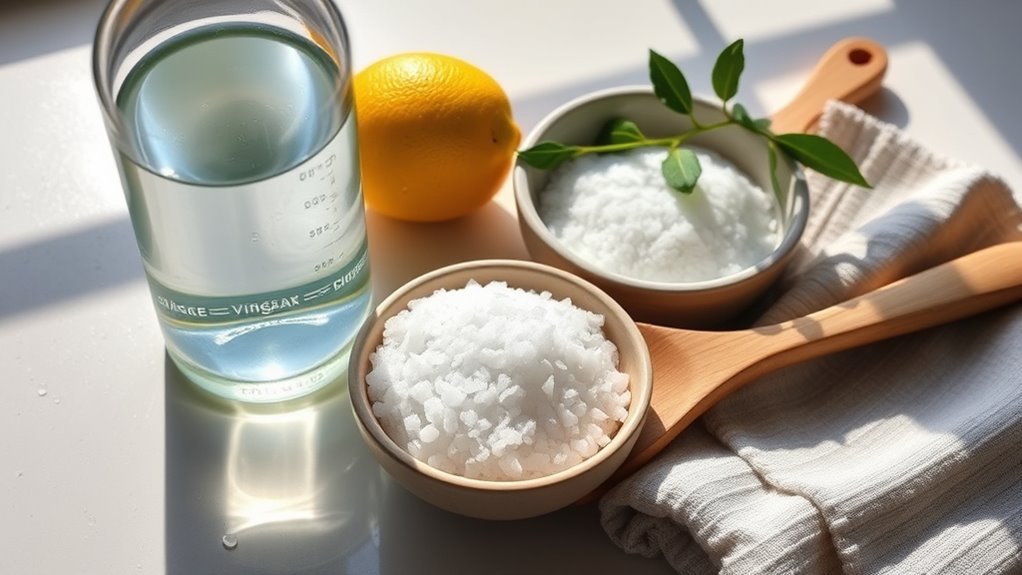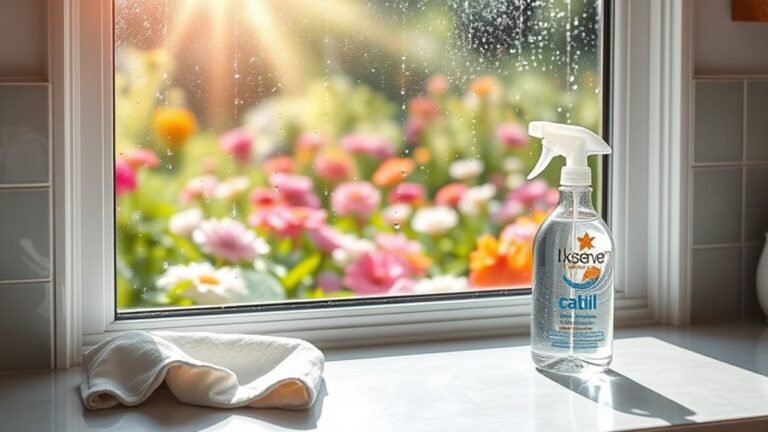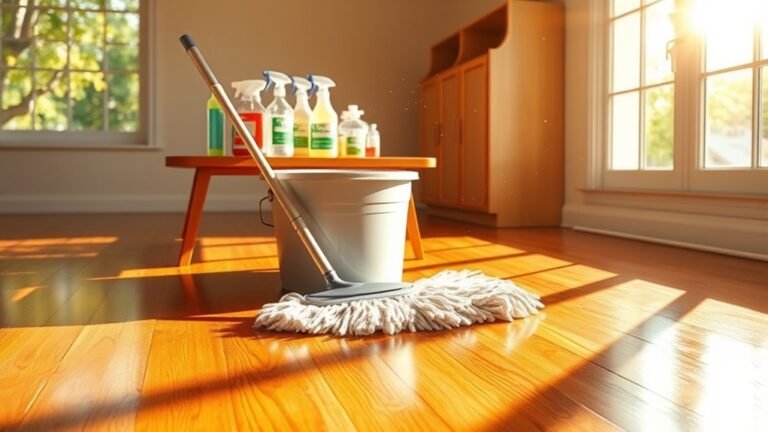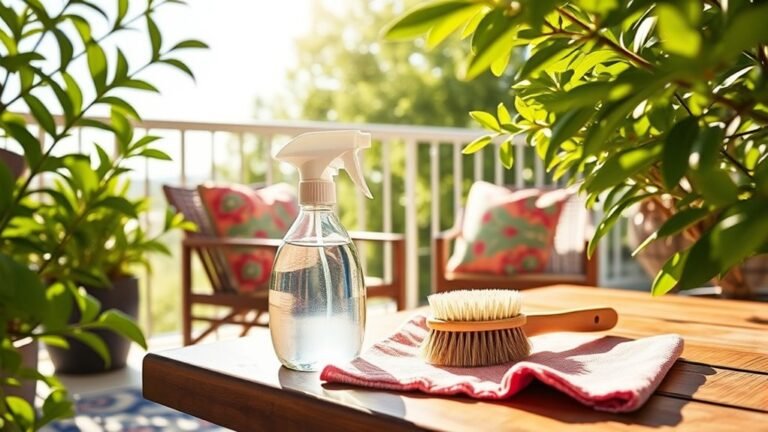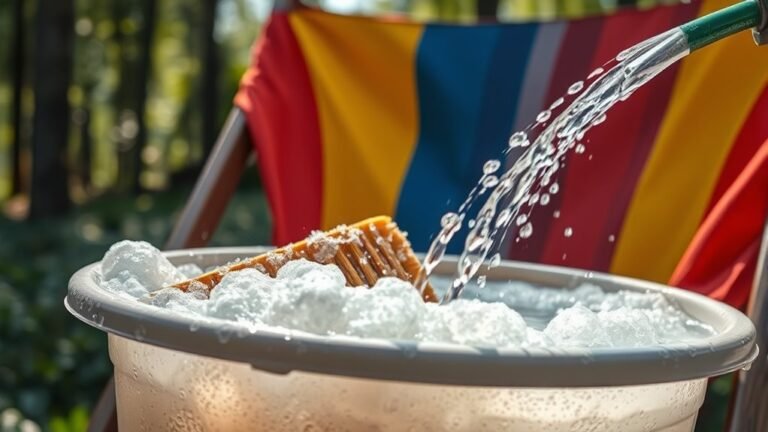How to Make Homemade Allergens Cleaner
You can make an effective homemade allergen cleaner by combining equal parts distilled water and white vinegar with a teaspoon of castile soap for gentle cleaning. Adding baking soda helps absorb odors and break down particles, while essential oils like tea tree provide antimicrobial benefits. Use this spray on surfaces regularly and guarantee proper ventilation during application. Storing your cleaner in an opaque container away from heat maintains its potency. Discovering more tips will help you manage allergens even better.
Understanding Common Allergens in the Home
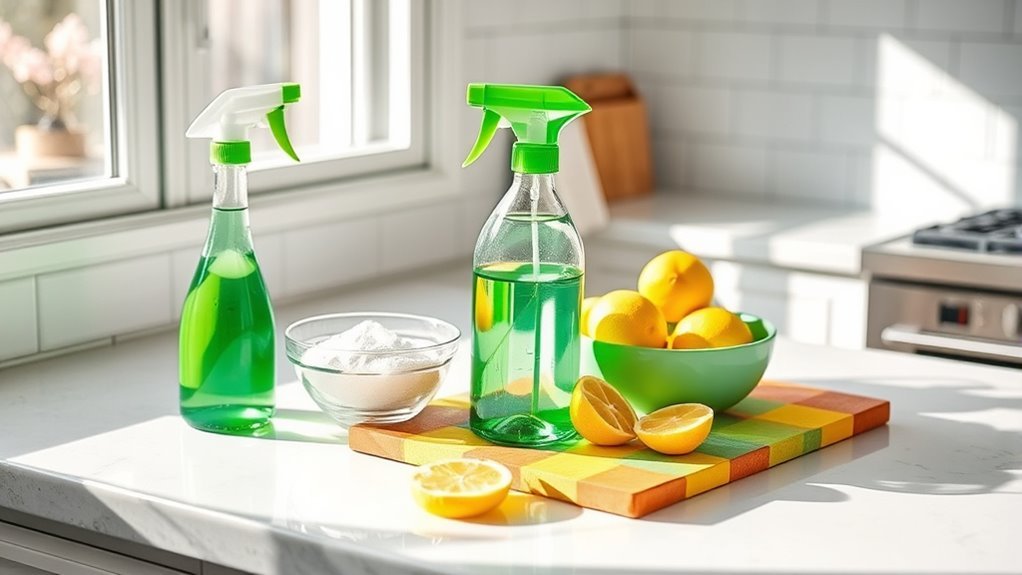
Although allergens can vary widely, the most common ones found in homes include dust mites, pet dander, mold spores, and pollen. You should know dust mites are microscopic arachnids thriving in warm, humid environments like bedding and upholstery. Their waste products trigger immune responses in sensitive individuals. Pet dander consists of tiny skin flakes shed by animals, which can remain airborne or settle on surfaces, causing allergic reactions. Mold spores, often found in damp areas, release airborne particles that irritate respiratory systems. Pollen, though primarily outdoor, can infiltrate indoor spaces through windows and ventilation. Understanding these allergens helps you target cleaning efforts effectively, enhancing your home’s air quality and your freedom from allergy symptoms. Recognizing their sources empowers you to control exposure and improve your living environment. Regular grooming sessions reduce shedding at the source, which can significantly decrease the amount of pet dander in your home.
Essential Ingredients for Homemade Allergen Cleaners
Knowing the primary allergens in your home allows you to select ingredients that effectively neutralize or remove them. When crafting homemade allergen cleaners, focus on sustainable alternatives that balance efficacy with safety. Each ingredient offers distinct benefits tailored to allergen control.
- White vinegar: Breaks down mold and dust mite residues.
- Baking soda: Absorbs odors and loosens particles.
- Essential oils (e.g., tea tree, eucalyptus): Provide antimicrobial properties.
- Hydrogen peroxide: Acts as a disinfectant against bacteria and fungi.
- Castile soap: Gently cleans without harsh chemicals.
Maintaining consistency in cleaning routines enhances the effectiveness of these homemade solutions.
Simple Recipes for All-Purpose Allergen Cleaner
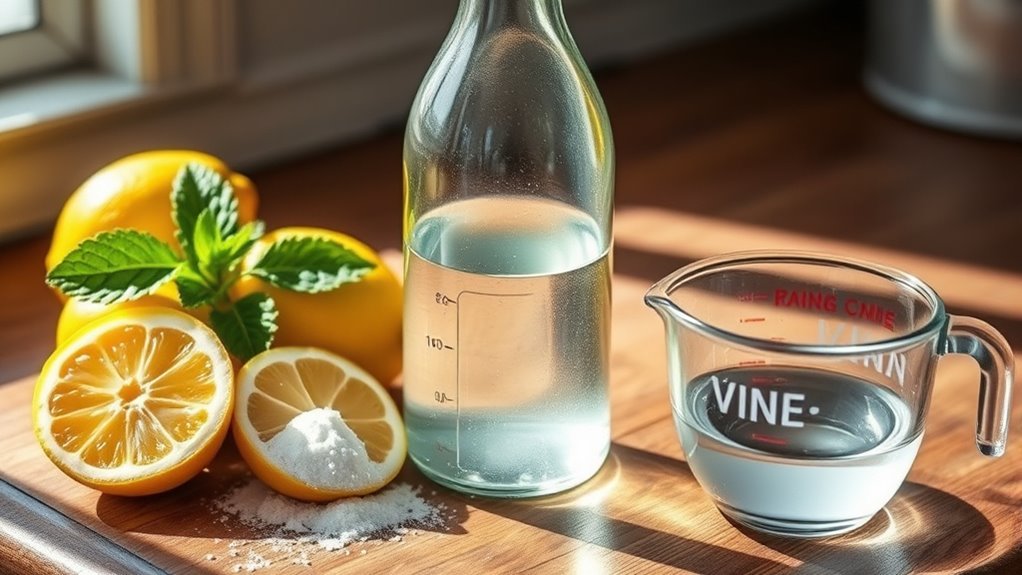
When you combine the essential ingredients correctly, you can create effective all-purpose allergen cleaners that target a variety of household allergens. A simple recipe includes 1 cup distilled water, 1 cup white vinegar, and 1 teaspoon liquid castile soap. This mixture acts as an eco friendly alternative to chemical cleaners, effectively breaking down dust, pet dander, and pollen residues. For those sensitive to fragrances, opt for scent free options by omitting essential oils or scented additives. Another formula involves 2 cups water mixed with 1 tablespoon baking soda, which neutralizes allergens and odors without harsh chemicals. Both recipes provide freedom from commercial allergens and toxins while maintaining cleaning efficiency. Remember to store your homemade cleaner in a spray bottle and shake before each use for best results. Maintaining a cleaning frequency of once or twice a week enhances the effectiveness of these homemade solutions.
How to Make a Natural Fabric Allergen Spray
To create an effective natural fabric allergen spray, you’ll need key ingredients such as distilled water, white vinegar, and essential oils with antimicrobial properties. You should apply the spray evenly on fabrics and allow them to air dry to maximize allergen neutralization. Proper usage and storage are essential to maintain the spray’s efficacy and prevent fabric damage. It is important to test cleaning solutions on a small, hidden area of fabric first to ensure compatibility and avoid damage.
Essential Ingredients Overview
Creating an effective natural fabric allergen spray relies on selecting ingredients with proven anti-allergenic and antimicrobial properties. By focusing on natural ingredients, you guarantee both safety and potent cleaning properties that reduce allergens without harsh chemicals. Here are five essential components you should consider:
- Distilled water: Serves as a pure solvent base, diluting concentrated elements safely.
- White vinegar: Naturally acidic, it breaks down allergenic proteins and inhibits microbial growth.
- Witch hazel: Offers gentle antiseptic qualities, enhancing allergen removal.
- Essential oils (e.g., eucalyptus, tea tree): Provide antimicrobial and anti-inflammatory effects, plus a fresh scent.
- Baking soda: Acts as a mild abrasive and deodorizer, lifting allergens from fabric fibers.
These ingredients combine to create a balanced spray, maximizing allergen elimination with minimal environmental impact.
Application Tips and Usage
Although natural allergen sprays are straightforward to prepare, knowing the correct application techniques guarantees maximum effectiveness. To optimize allergen removal, spray evenly on fabric surfaces from 6-8 inches away, allowing adequate drying time. Adjust cleaner frequency based on allergen exposure, typically twice weekly in high-traffic areas. Avoid oversaturation to prevent fabric damage.
| Surface Type | Application Technique | Recommended Cleaner Frequency |
|---|---|---|
| Upholstery | Light mist, even coverage | Twice weekly |
| Curtains | Moderate spray, full coverage | Weekly |
| Bedding | Light spray, focus on seams | Biweekly |
Tips for Using Homemade Cleaners Safely and Effectively
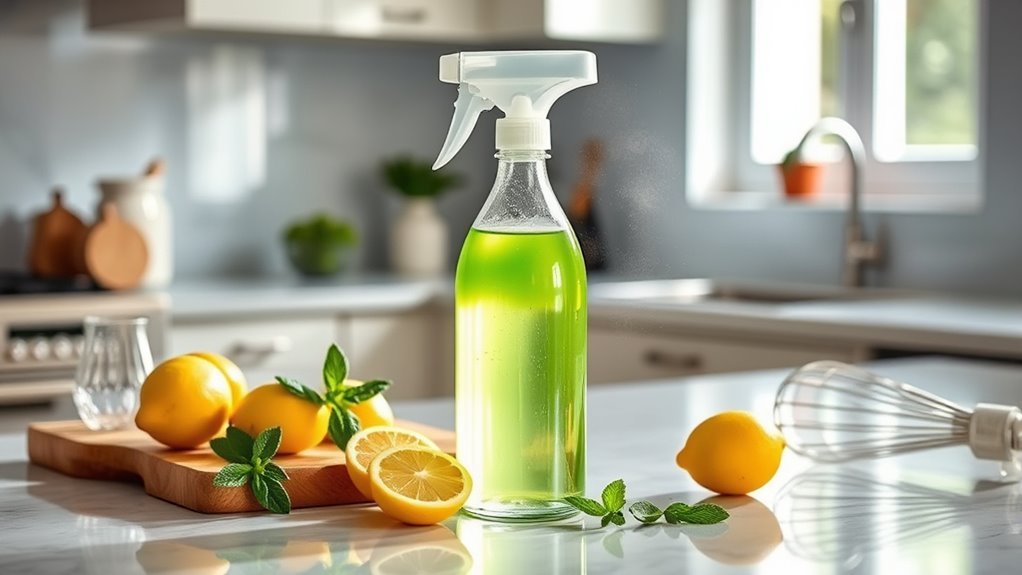
To guarantee your homemade allergen cleaners remain effective and safe, you’ll need to store them in airtight containers away from direct sunlight and extreme temperatures. When applying these cleaners, always use gloves and test on a small area first to avoid adverse reactions. Following these precautions will help maintain both the cleaner’s potency and your safety. Additionally, remember that natural cleaners may not provide the same disinfecting power as commercial products, so use them accordingly.
Proper Storage Methods
When storing homemade allergen cleaners, you’ll need to verify containers are airtight and made from non-reactive materials like glass or high-quality plastic to maintain chemical stability. Proper container selection is vital to prevent degradation of active ingredients and contamination. To guarantee ideal storage conditions, keep your cleaners in a cool, dark place away from direct sunlight and heat sources, which can alter their effectiveness. Label each container clearly with contents and preparation date to track freshness. Avoid storing near strong-smelling substances to prevent cross-contamination.
- Use amber or opaque containers to block light exposure
- Store at consistent room temperature, ideally 15–25°C (59–77°F)
- Keep containers tightly sealed when not in use
- Place cleaners out of reach of children and pets
- Avoid metal containers that may react chemically with ingredients
Safe Application Techniques
Three essential practices guarantee you apply homemade allergen cleaners safely and effectively. First, always test a small surface area to prevent damage. Second, wear gloves to protect your skin from irritants. Third, ascertain proper ventilation to avoid inhaling fumes. These safe application steps optimize cleaning techniques while preserving your well-being.
| Step | Description |
|---|---|
| Surface Test | Apply cleaner to a discreet spot |
| Protective Gear | Wear gloves and optionally a mask |
| Ventilation | Open windows or use fans during use |
| Application Method | Use soft cloths or spray bottles |
Maintaining an Allergen-Free Environment Regularly
Although creating an effective homemade allergen cleaner is essential, maintaining an allergen-free environment requires consistent and systematic cleaning practices. You’ll need to establish allergen free routines combined with regular cleaning to prevent allergen accumulation and exposure. Consistency is key to minimizing irritants effectively.
Incorporate these steps into your routine:
- Vacuum floors and upholstery with a HEPA filter vacuum at least twice weekly.
- Wash bedding and curtains in hot water weekly to eliminate dust mites.
- Use your homemade allergen cleaner on hard surfaces daily.
- Maintain low indoor humidity (30–50%) to reduce mold growth.
- Keep pets groomed and off bedding to limit dander spread.
- Additionally, using natural cleaning agents like vinegar and baking soda ensures safe and non-toxic allergen removal.
Frequently Asked Questions
Can Homemade Allergen Cleaners Be Used on Pet Bedding?
You can use homemade allergen cleaners on pet bedding, but you’ve got to be cautious. Choose gentle, non-toxic ingredients to avoid irritating your pet’s skin or respiratory system. Always test a small area first and rinse thoroughly to remove residues. Following proper cleaning tips, like washing bedding regularly and drying it completely, helps reduce allergens effectively while keeping your pet safe and comfortable. This approach gives you control over your pet’s environment.
How Long Do Homemade Allergen Cleaners Stay Effective After Making?
Like fresh juice, homemade allergen cleaners have a limited shelf life—typically about one to two weeks. To keep their potency, you should store them in airtight containers, away from direct sunlight and heat, which degrade active ingredients faster. Refrigeration can help extend effectiveness slightly. Since these cleaners lack preservatives, using them promptly guarantees maximum allergen removal and safety, giving you the freedom to maintain a clean environment without harsh chemicals.
Are Homemade Allergen Cleaners Safe for People With Sensitive Skin?
If you have sensitive skin, you’ll want to be cautious with homemade allergen cleaners. They often contain sensitive ingredients like vinegar or essential oils, which can cause skin reactions in some people. It’s wise to test a small area first or wear gloves during use. Choosing milder, hypoallergenic components can help reduce irritation, allowing you to clean effectively without compromising your skin’s health or your freedom to control what you use.
Can These Cleaners Remove Mold Allergens Effectively?
You can effectively target mold allergens using homemade cleaners, but their success depends on the ingredients used. For mold removal, solutions with antifungal properties—like vinegar or hydrogen peroxide—work well against allergen sources. However, these cleaners might not eliminate mold spores as thoroughly as commercial products designed specifically for mold remediation. To guarantee all-encompassing allergen control, you’ll want to combine cleaning with proper ventilation and moisture control strategies around your home.
How Do Homemade Allergen Cleaners Compare to Commercial Products?
While commercial products promise quick, potent allergen removal, homemade allergen cleaners offer natural ingredients benefits that commercial ones often lack, like reduced chemical exposure and environmental impact. You’ll find homemade options generally cost less, providing a favorable cost comparison. However, commercial cleaners undergo rigorous testing for efficacy, ensuring consistent results. If you seek freedom from harsh chemicals and budget constraints, homemade cleaners can be effective, but commercial products might guarantee faster, more reliable allergen elimination.
